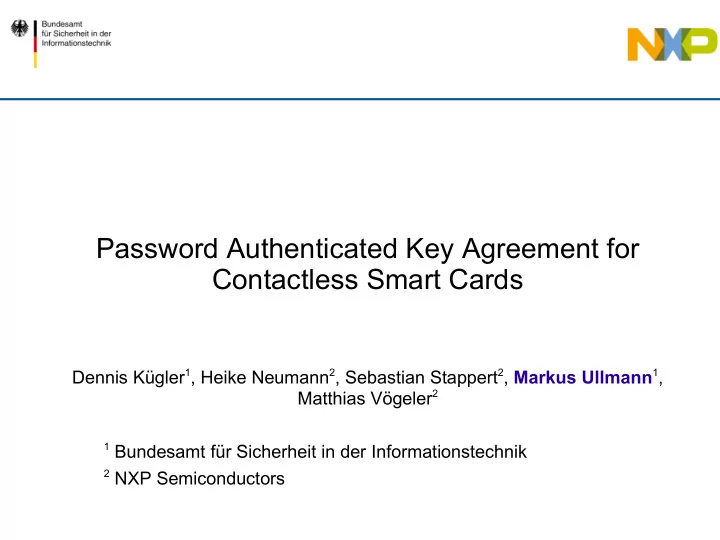

Password Authenticated Key Agreement for Contactless Smart Cards Dennis Kügler 1 , Heike Neumann 2 , Sebastian Stappert 2 , Markus Ullmann 1 , Matthias Vögeler 2 1 Bundesamt für Sicherheit in der Informationstechnik 2 NXP Semiconductors
Outline Security attacks concerning contactless smart cards Security limitation of former solution Password-based cryptographic protocols Features of password-based protocols PACE TC-AMP Comparison PACE – TC-AMP Conclusion
Contactless Smart Card (optical character recognitation component) contactless radio frequency smart card interface device (picc) (pcd) / ISO 14443 reader Security Attacks 1. Unauthorized communication with the smart card 2. Eavesdropping of an existing pcd-picc communication Folie 3
ePassport: BAC-Protocol Read MRZ optically Inspection System RF-Chip Calculate Access Key K from optically read MRZ Challenge r Chip Choose r Chip randomly Choose r Reader randomly Choose key K Chip Choose key K Reader Ciphertext decrypt... encrypt... E K (r Reader ,r Chip ,K Reader ) r Chip correct? Ciphertext encrypt... decrypt... E K (r Chip ,r Reader ,K Chip ) r Reader correct? Limitations Entropy of the derived session key BAC key is static Base ideas for contactless cards Two channels (optic channel, magnetic channel) „Representation“ of former border control operation Folie 4
Contactless Card Operation Smart card with contact interface Card operation is only possible if the card is physically connected to the terminal Contactless card We are locking for a mechanism which „represents“ this connection process for contactless smart cards => secure connection establishment between contactless smart card and terminal Folie 5
Password Based Cryptographic Protocols Security Usage Client Server Authentication Approaches Encrypted Key Exchange (EKE), Bellovin and Merret 1992 ... TP-AMP, Taekyoung Kwon 2004 Features Strong session key agreement Implicit entity authentication based on a shared secret of low entropy Folie 6
Password Based Cryptographic Protocols (2) Secure connection establishment between smart card and terminal Password Authenticated Connection Establishment (PACE), 2006 Terminal-Card-TP-AMP (TC-AMP), „simplified TP-AMP“, 2008 Low entropy of the password e.g. 6 digits => 10 6 passwords Adversary knows in principle the whole set of possible passwords Folie 7
Structure of PACE π 643215 pcd picc 1.Precondition: common elliptic curve E , base point G 2.Key derivation, selection of a random number s μ = h(π|1) mod n ← z = Encryption(μ, s) s = Decryption(μ, z) 3.Calculation of a random curve Point P (anonymous DH) 4.Mapping s → elliptic curve E G' = s * G + P 5.Calculation of a common secret curve point K anonymous DH using G' 6.Mutual Authentication of picc and pcd MAC(k MAC , PK picc ) → ← MAC(k MAC , PK pcd ) Folie 8
Security Requirements General Requirements Authentication of terminals Strong session key agreement Forward secrecy of the session keys Specific Requirements Concerning Password Based Protocols Security against off-line dictionary attacks Security against on-line dictionary attacks Type (1): can't abuse the protocol to eliminate passwords Type (2): test at most one password per protocol run Folie 9
Security of PACE Authentication of terminals „secrecy of π“, knowing and using π Strong session key agreement computational DH assumption Forward secrecy of the session keys random calculation of curve point K Security against off-line dictionary attacks if s is choosen randomly, z is also randomly (password-based encryption is a pseudorandam permutation) Security against on-line dictionary attacks Type (1): can't abuse the protocol to eliminate passwords s < 2 m (m: Blocksize of the used blockcipher) Type (2): test at most one password per protocol run Folie 10
Structure of TC-AMP π 643215 pcd picc 1.Precondition: common elliptic curve E , base point G 2.Key derivation, mapping π → elliptic curve E μ = h(0|π|0) mod n Γ 0 = μ * G Γ 1 = μ * G' (G' = l * G, l unknown) 3.Calculation of random curve points M = (x * G) + Γ 1 ' (x random) → ← Q = y * Γ 0 (y random) 4.Calculation of a common secret curve point A = B A = μ -1 (x + M x ) * Q B = y *(M+ Γ 1 + (M x * G)) 5.Mutual authentication of picc and pcd h(3|M x |A x |Q x |3) → ← h(2|M x |B x |Q x |2) Folie 11
Security of TC-AMP Authentication of terminals „secrecy of π“, knowing and using π Strong session key agreement intractability assumption of the discrete logarithm problem, cryptographic strength of the hash function Forward secrecy of the session keys random calculation of curve point A = B Security against off-line dictionary attacks M and Q are choosen randomly Security against on-line dictionary attacks Type (1): can't abuse the protocol to eliminate passwords injective Mapping π → Γ 0 Type (2): test at most one password per protocol run Folie 12
Comparison PACE - TC-AMP PACE TC-AMP EC mapping: s → E π → E Mapping G, G': G' = s * G + P G' = l * G (dynamic) (static) Authentication: MAC-calculation Hash-generation Implementation: 5 APDUs 3 APDUs Performance: 945 ms 978 ms (SmartMX) Folie 13
PACE Performance Folie 14
TC-AMP Performance Folie 15
Conclusion Presentation of two password based protocols for secure connection establishment between contactless smart card and terminal Intention to use PACE for the next generation of german ID cards (contactless ISO 14443 interface) Formal cryptographic and logical proofs of security are subject of current studies On-line dictionary attacks are ever possible (security mechanism: time delay between failed protocol runs) Future work: Javacard implementation of PACE and TC-AMP (Sun-JavaCard-API: EC-arithmetic is missing) Folie 16
Recommend
More recommend